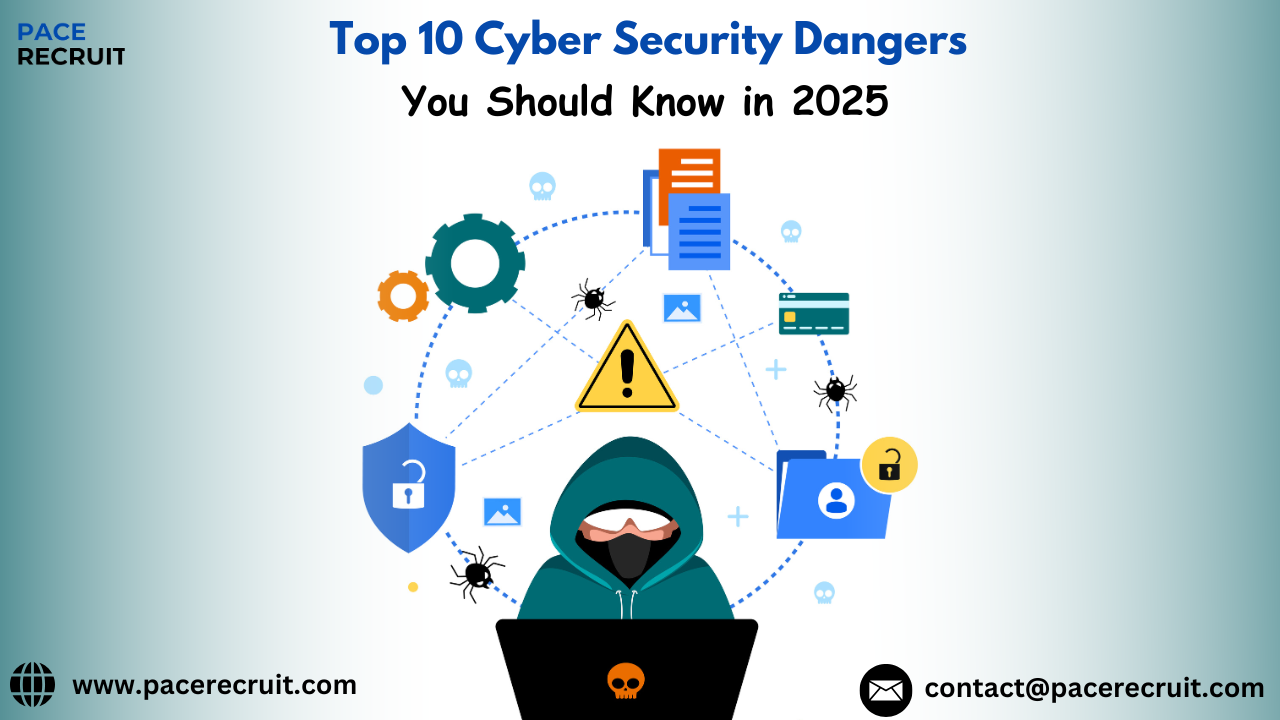Top 10 Cyber Security Dangers in 2025: Along with moving technology, cyber security also develops the dangers facing businesses, governments and individuals. 2025 will see even more sophisticated conditions of cyber threats, calling for eternal vigilance and active safety measures. Here, we present the top 10 cyber security dangers that you should know in 2025.
Table of Contents
1. AI-operated cyber attacks
Artificial Intelligence (AI) is revolutionizing companies, but is also being exploited by cyber criminal. AI-operated malware and self-propaging hacking tools are rapidly, smarter and more difficult to identify cyber attacks. The attackers can now create adaptive fishing campaigns, automatic deepfec fraud, and even exploit weaknesses automatically in real time.
AI-AI-malicious AI to find out the AI-operated danger to combat the attack attack.
Update regular AI-based safety algorithms.
Train staff on AI-based fishing scam.
2. Ransomware and Double Extortion Evolution
Ransomware attacks continue to be one of the most damaging of the cybersecurity attacks. Cyberthieves are evolving to double extortion methods, which not only involve encrypting files but also to publish them in the public domain unless a ransom is paid.
- Preventing Ransomware AttacksRegular encrypted backups.
- Implement network segmentation to quarantine ransomware distribution.
- Enforce zero-trust security architectures to reduce attack surfaces.
3. Deepfake Scams and Social Engineering
Deepfake technology continues to evolve and become more prevalent, enabling cybercriminals to effectively impersonate executives, politicians, or loved ones. Deepfake audio and video are being used by cybercriminals to trick people and organizations into money transfers or exposing sensitive information.
- How to Combat Deepfake ThreatsUse deepfake detection tools.
- Enforce multi-factor authentication (MFA) for validation.
- Educate staff and executives regarding deepfake scams.
4. Supply Chain Attacks
Supply chain attacks rank among the leading security threat trends, wherein hackers get into trusted third-party vendors to reach a larger company. This technique of attack was seen in the SolarWinds hack and is forecasted to increase in 2025.
- Securing Your Supply ChainConduct thorough security scans on third-party vendors.
- Implement zero-trust models to limit external access.
- Monitor supply chain networks for threats.
5. IoT Device Exploits
The growth of Internet of Things (IoT) devices brings with it new threats as most IoT devices are not suitably secured. Smart homes, smart vehicles, and industrial IoT networks are the focus for hackers to gain unauthorized entry.
- Best Practices for IoT SecurityUtilize unique, strong passwords for each IoT device.
- Regularly update firmware and software.
- Isolate IoT networks from business core infrastructure.
6. Cloud Security Breaches
With the shift of companies to cloud computing, hackers are finding new ways to utilize misconfigurations, inadequate access controls, and exposed APIs to launch attacks. Cloud security breaches can lead to data leaks, financial losses, and damage to reputation.
- Securing Your Cloud DataMake end-to-end encryption of cloud storage mandatory.
- Use identity and access management (IAM) tools.
- Conduct cloud security audits regularly.
7. 5G Network Vulnerabilities
With the worldwide deployment of 5G, there are new attack surfaces. 5G networks raise the risk of man-in-the-middle attacks, DDoS exploits, and IoT vulnerabilities because of the sheer number of connected devices.
- How to Secure 5G NetworksImplement zero-trust security principles for network traffic.
- Protect 5G endpoints with robust authentication controls.
- Partner with trusted telecom providers that value security.
8. Cryptojacking and Blockchain Attacks
Cryptojacking is a phenomenon where cyber attackers take over computing power to mine cryptocurrency secretly without the user’s approval. With increasing adoption of blockchain, attackers also target smart contract vulnerabilities to pilfer digital currency.
- Preventing Cryptojacking ThreatsTrack CPU and GPU usage for sudden surges.
- Employ browser plug-ins that thwart mining scripts.
- Adopt blockchain security best practices.
9. Insider Threats and Employee Negligence
Malicious insiders or careless employees remain a top cybersecurity threat. Either deliberate or accidental, insider data breaches can have catastrophic consequences.
- Preventing Insider ThreatsEnforce rigorous access controls and monitoring.
- Offer frequent cybersecurity training.
- Use behavior analytics tools to identify abnormal behavior.
10. Quantum Computing and Cryptographic Vulnerabilities
While quantum computing has immense potential, it also poses an extreme threat to current encryption protocols. An incredibly powerful quantum computer can decrypt present encryption schemes, rendering sensitive data unprotected.
- Preparation for the Quantum EraImplement post-quantum cryptography.
- Monitor quantum computing threat development.
- Consult with cybersecurity experts to assess future threats.
Get in Touch Today
Partner with PACE Recruit to build a resilient cybersecurity team that protects your business from evolving threats. Contact us now to discuss your cybersecurity recruitment needs at https://www.pacerecruit.com/contact-us/
FAQs about Top 10 Cyber Security Dangers in 2025
1. How can companies defend against AI-driven cyber attacks?
Companies can use AI-based security software, train staff, and constantly update security mechanisms to respond to changing AI threats.
2. Which sectors are most vulnerable to ransomware attacks?
Sectors such as healthcare, finance, and government sectors are major targets because they possess sensitive information.
3. How do people identify deepfake scams?
Verify visual inconsistencies, and irregular speech, and use deepfake detection software.
4. How can companies secure their supply chains?
Conduct security scans, use multi-layered authentication, and monitor third-party vendor activity.
5. Will quantum computing make old encryption obsolete?
Quantum computers can break existing encryption methods, and companies must move to post-quantum cryptography.

